The Intel Optane Memory (SSD) Preview: 32GB of Kaby Lake Caching
by Billy Tallis on April 24, 2017 12:00 PM EST- Posted in
- SSDs
- Storage
- Intel
- PCIe SSD
- SSD Caching
- M.2
- NVMe
- 3D XPoint
- Optane
- Optane Memory
Sequential Read
Sequential access is usually tested with 128kB transfers, which is large enough that requests can typically be striped across multiple controller channels and still involve writing a full page or more to the flash on each channel. Real-world sequential transfer sizes vary widely depending on factors like which application is moving the data or how fragmented the filesystem is.
The drives were preconditioned with two full writes using 4kB random writes, so the data on each drive is entirely fragmented. This may limit how much prefetching of user data the drives can perform on the sequential read tests, but they can likely benefit from better locality of access to their internal mapping tables. These tests were conducted on the Optane Memory as a standalone SSD, not in any caching configuration.
Queue Depth 1
The test of sequential read performance at different transfer sizes was conducted at queue depth 1. Each transfer size was used for four minutes, and the throughput was averaged over the final three minutes of each test segment.
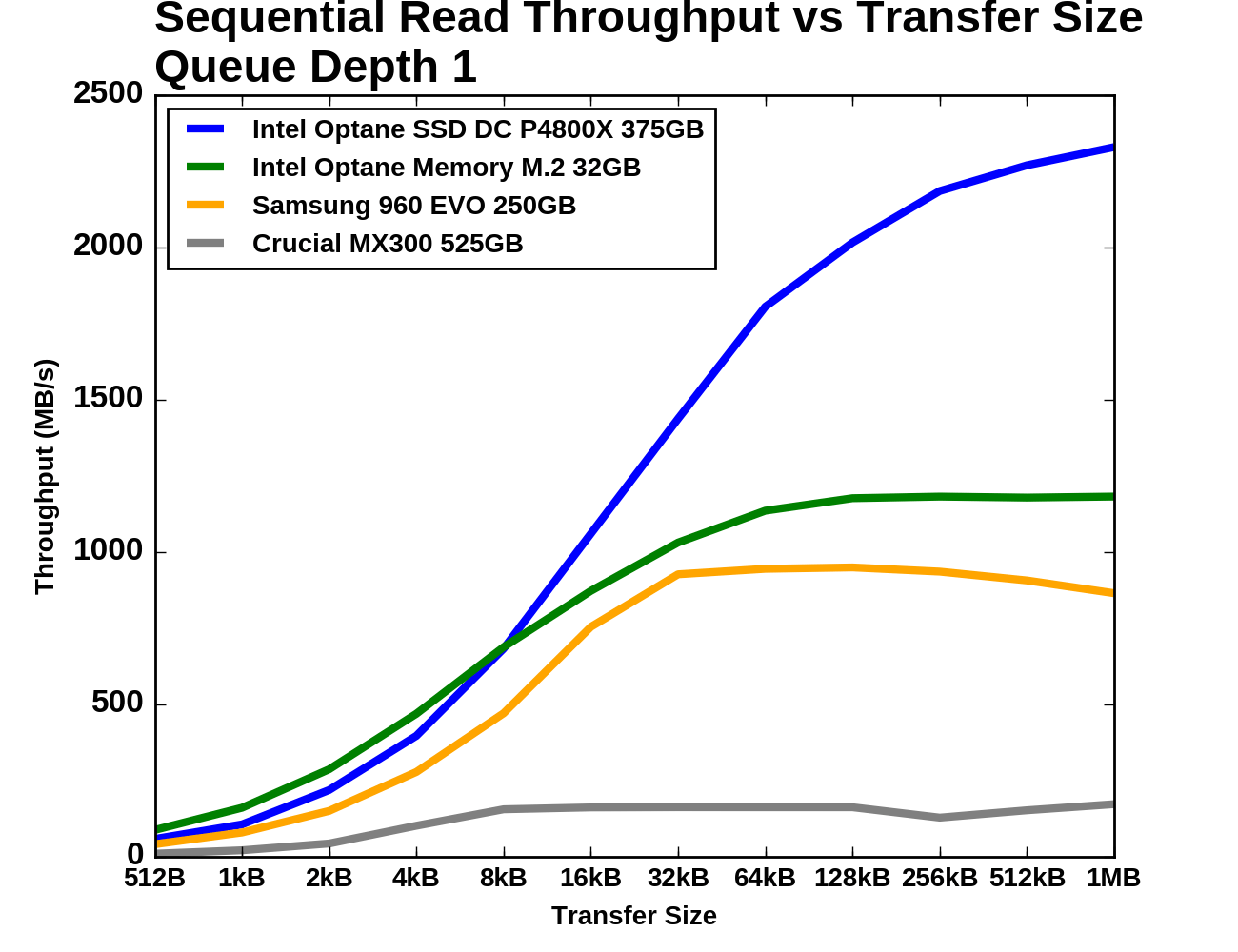 |
|||||||||
| Vertical Axis scale: | Linear | Logarithmic | |||||||
The three PCIe drives show similar growth through the small to mid transfer sizes, but the Optane Memory once again has the highest performance for small transfers and higher performance across the board than the Samsung 960 EVO.
Queue Depth > 1
For testing sequential read speeds at different queue depths, we use the same overall test structure as for random reads: total queue depths of up to 64 are tested using a maximum of four threads. Each thread is reading sequentially but from a different region of the drive, so the read commands the drive receives are not entirely sorted by logical block address.
The Samsung 960 EVO and Optane Memory start out with QD1 sequential read performance and latency that is relatively close, but then at higher queue depths the Optane Memory jumps up to a significantly higher throughput.
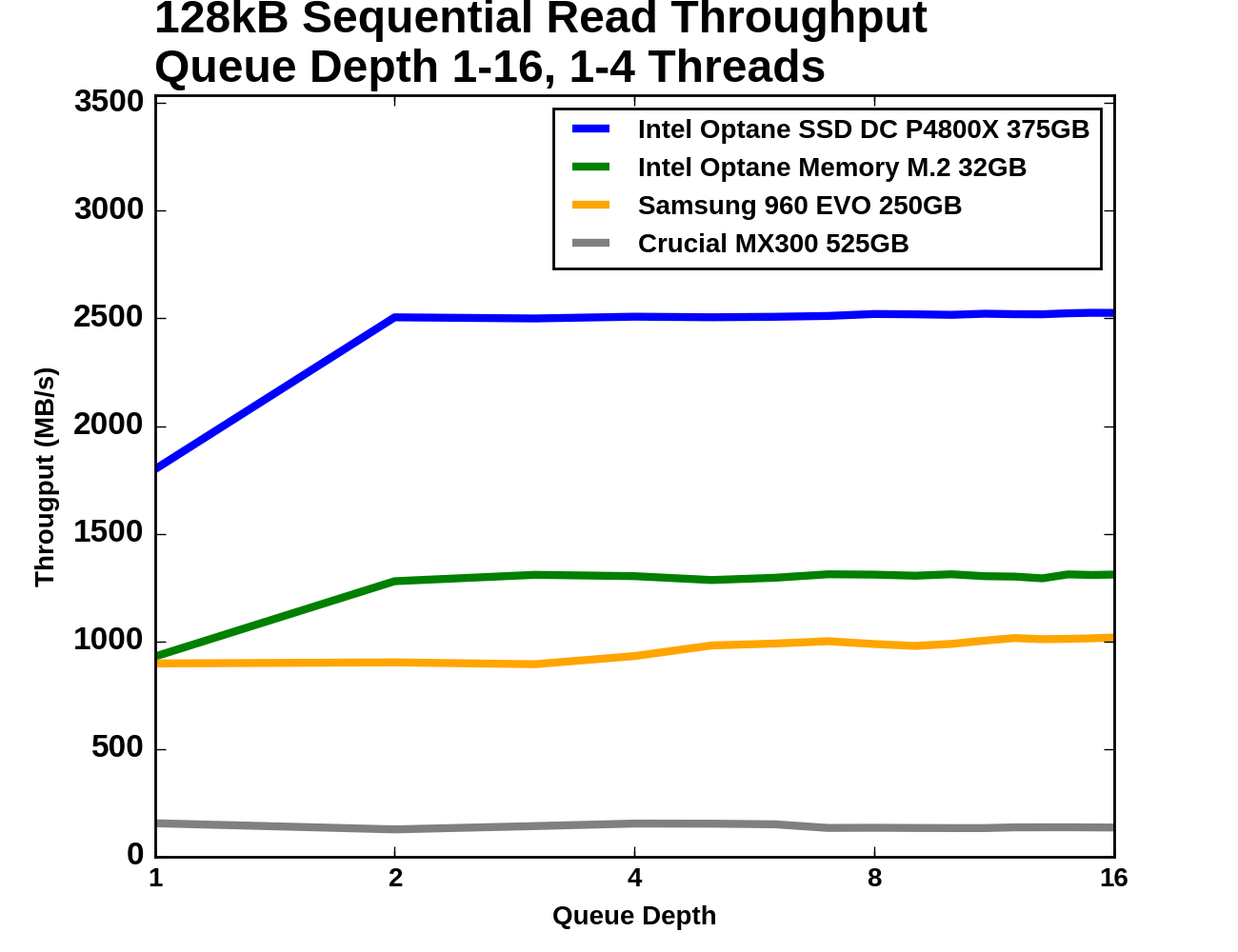 |
|||||||||
| Vertical Axis scale: | Linear | Logarithmic | |||||||
The two Optane devices saturate for sequential reads at QD2, but the Optane Memory experiences a much smaller jump from its QD1 throughput. The flash SSDs are mostly saturated from the start. The Crucial MX300 delivers far lower performance than SATA allows for, due to this test being multithreaded with up to four workers reading from different parts of the drive.
 |
|||||||||
| Mean | Median | 99th Percentile | 99.999th Percentile | ||||||
Since all four drives are saturated through almost all of this test, the latency graphs are fairly boring: increasing queue depth increases latency. For mean and median latency the Optane Memory and the Samsung 960 EVO are relatively close, but for the 99th and 99.999th percentile metrics the 960 EVO is mostly slower than the Optane Memory by about the same factor of two that the P4800X beats the Optane Memory by.
Sequential Write
The sequential write tests are structured identically to the sequential read tests save for the direction the data is flowing. The sequential write performance of different transfer sizes is conducted with a single thread operating at queue depth 1. For testing a range of queue depths, a 128kB transfer size is used and up to four worker threads are used, each writing sequentially but to different portions of the drive. Each sub-test (transfer size or queue depth) is run for four minutes and the performance statistics ignore the first minute. These tests were conducted on the Optane Memory as a standalone SSD, not in any caching configuration.
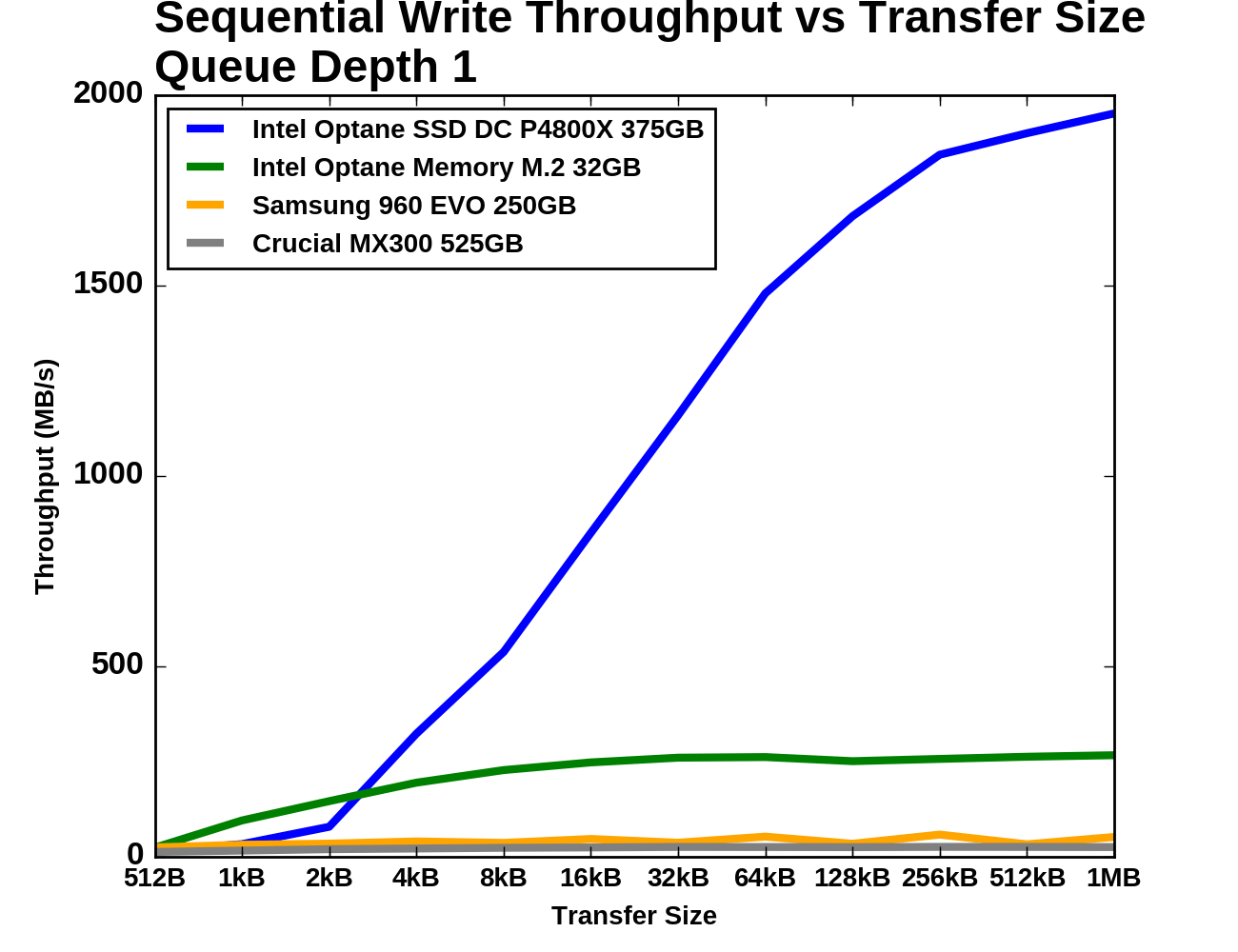 |
|||||||||
| Vertical Axis scale: | Linear | Logarithmic | |||||||
The enterprise-focused Optane SSD P4800X is slower than the consumer Optane Memory for sequential writes of less than 4kB, and even the Samsung 960 EVO beats the P4800X at 512B transfers. The 960 EVO's performance is inconsistent through the second half of the test but on average it is far closer to the MX300 than either Optane device. For larger transfers the MX300 is about a tenth the speed of the Optane Memory.
Queue Depth > 1
The sequential write throughput of the Optane SSD DC P4800X dwarfs that of the other three drives, even the Optane Memory. The Optane Memory does provide substantially higher throughput than the flash SSDs, but it does not have a latency advantage for sequential writes.
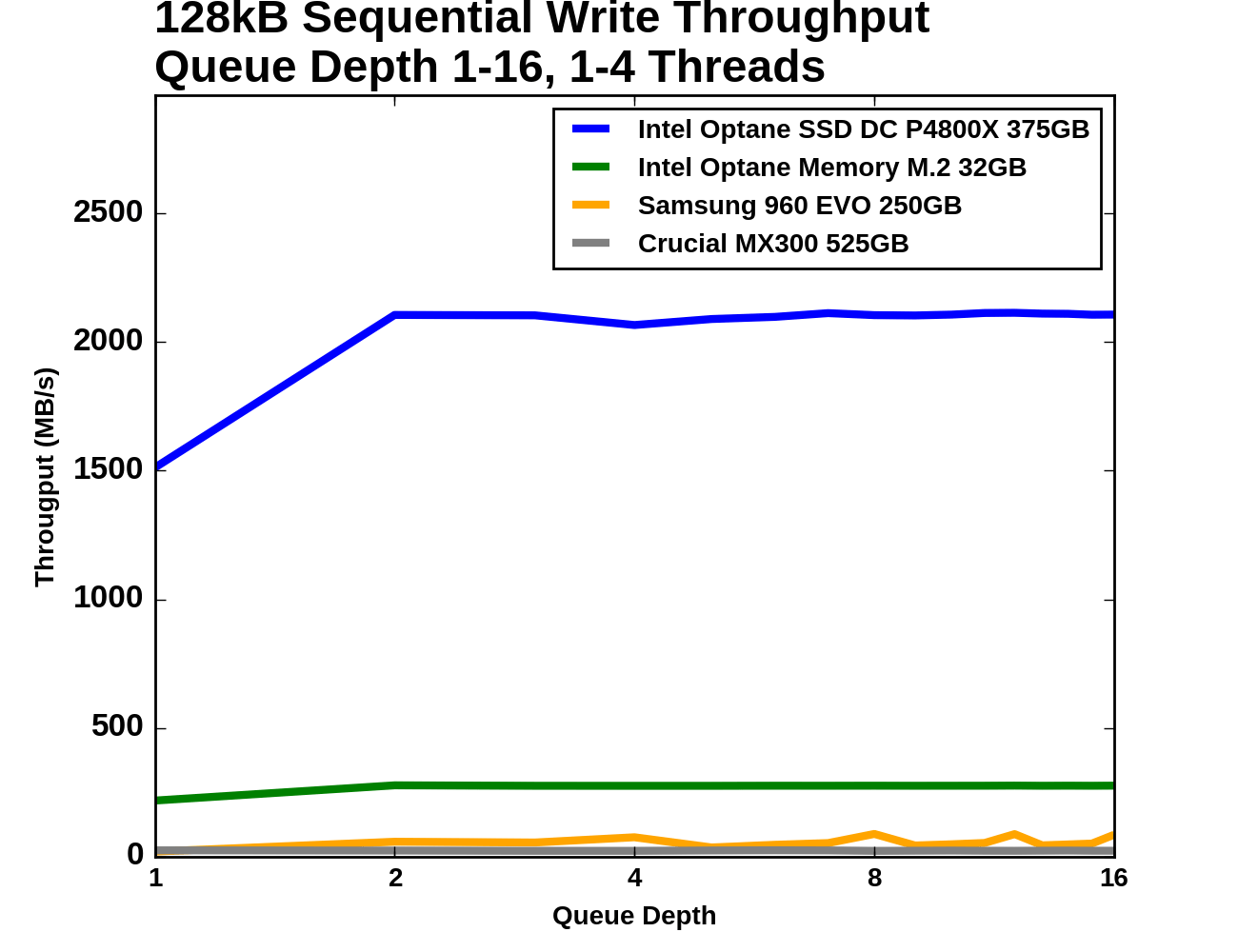 |
|||||||||
| Vertical Axis scale: | Linear | Logarithmic | |||||||
The Crucial MX300 is the only drive that does not get a throughput boost going from QD1 to QD2; as with the random write test it is not able to improve performance when the higher queue depth is due to multiple threads writing to the drive. The Samsung 960 EVO improves from the addition of a second thread but beyond that it simply gets more inconsistent. The Optane Memory and P4800X are both very consistent and saturated at QD2 after a moderate improvement from QD1.
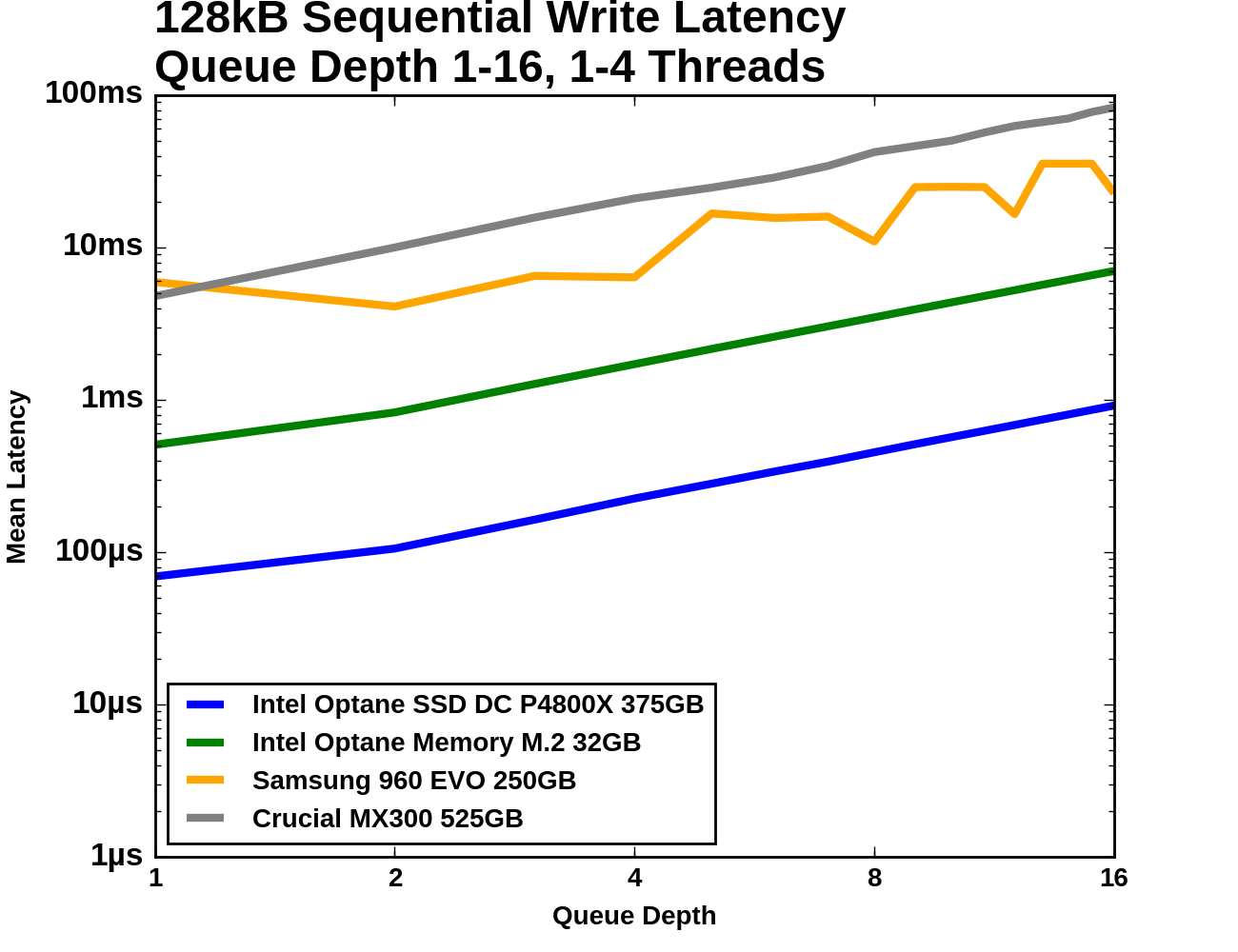 |
|||||||||
| Mean | Median | 99th Percentile | 99.999th Percentile | ||||||
The flash SSDs get more inconsistent with increased thread count and queue depth, but other than that the latency charts show the predictable growth in latency that comes from the drives all being saturated in terms of throughput.












110 Comments
View All Comments
BrokenCrayons - Monday, April 24, 2017 - link
A desktop Linux distro would fit nicely on it with room for local file storage. I've lived pretty happily with a netbook that had a 32GB compact flash card on a 2.5 inch SATA adapter that had Linux Mint 17.3 on it. The OS and default applications used less than 8GB of space. I didn't give it a swap partition since 2GB was more than enough RAM under Linux (system was idle at less than 200MB and I never saw it demand more than 1.2GB when I was multi-tasking). As such, there was lots of space to store my music, books, and pics of my cat.ddriver - Monday, April 24, 2017 - link
And imagine how well DOS will run. And you have ample space for application and data storage. 32 gigs - that's what dreams were made of in the early 90s. Your music, books and cat pics are just icing on the cake. Let me guess, 64 kbit mp3s right?BrokenCrayons - Monday, April 24, 2017 - link
I'm impressed at the level of your insecurity.mkozakewich - Thursday, April 27, 2017 - link
I've made the decision to never read any comment with his name above, but sometimes I accidentally miss it.DanNeely - Monday, April 24, 2017 - link
Looking at the size of it, I'm wondering why they didn't make a 48GB model that would fill up the 80mm stick fully. Or, and unless the 3xpoint dies fully fill the area in the packages make them slightly smaller to support the 2260 form factor (after accounting for the odds and ends at the end of the stick the current design it looks like it's just too big to fit on the smaller size).CaedenV - Monday, April 24, 2017 - link
Once again, I have to ask.... who on earth is this product for?So you have a cheap $300 laptop, which is going to have a terrible display, minimal RAM, and a small HDD or eMMC drive... are they expecting these users to spring for one of these drives to choke their CPU?
Maybe a more mainstream $5-900 laptop where price is still ultra competitive. What sales metric does this add to which will promote sales over a cheaper device with seemingly the same specs? Either it will have a SSD onboard already and the performance difference will be un-noticed, or it will have a large HDD and the end-user is going to scratch their heads wondering why 2 seemingly identical computers have 4GB of RAM and 1TB HDD, but one costs $100 more.
Ok, so maybe it is in the premium $1-2000 market. Intel says it isn't aiming at these devices, but they are Intel. Maybe they think a $1-2000 laptop is an 'affordable' mass-market device? Here you are talking about ultrabooks; super slim devices with SSDs... oh, and they only have 1 PCIe slot on board. Just add a 2nd one? Where are you going to put it? Going to add more weight? More thickness? A smaller battery? And even after you manage to cram the part in one of these laptops... what exactly is going to be the performance benefit? An extra half a second when coming out of sleep mode? Word opens in .5 sec instead of .8 sec? Yes, these drives are faster than SSDs... but we are way past the point of where software load times matter at all.
So then what about workstation laptops. That is where these look like they will shine. A video editing laptop, or desktop replacement. And for those few brave souls using such a machine with a single HDD or SSD this seems like it would work well... except I don't know anyone like that. These are production machines, which means RAID1 in case of HDD failure. And this tech does not work with RAID (even though I don't see why not... seems like they could easily integrate this into the RAID controller). But maybe they could use the drive as a 3rd small stand-alone render drive... but that only works in linux, not windows. So, nope, this isn't going to work in this market either.
And that brings us to the desktop market. For the same price/raid concerns this product really doesn't work for desktops either, but the Optate SSDs coming out later this year sound interesting... but here we still have a pretty major issue;
SATA3 vs PCIe m.2 drives have an odd problem. On paper the m.2 drives benchmark amazingly well. And in production environments for rendering they also work really well. But for work applications and games people are reporting that there is little to no difference in performance. Intel is trying to make the claim that the issue is due to access time on the controllers, and that the extremely fast access time on Optane will finally get us past all that. But I don't think that is true. For work applications most of the wait time is either on the CPU or the network connection to the source material. The end-user storage is no longer the limiting factor in these scenarios. For games, much of the load time is in the GPU taking textures and game data and unpackaging them in the GPU's vRAM for use. The CPU and HDD/SSD are largely idle during this process. Even modern HDDs keep up pretty well with their SSD brethren on game load times. This leads me to believe that there is something else that is slowing down the whole process.
And that single bottleneck in the whole thing is Intel. It is their CPUs that have stopped getting faster. It is their RAM management that rather sucks and works the same speed no matter what your RAM is clocked at. It is the whole x86 platform that is stagnant and inefficient which is the real issue here. It is time for Intel to stop focusing on its next die-shrink, and start working on a new modern efficient instruction set and architecture that can take advantage of all this new tech! Backwards compatibility is killing the computer market. Time to make a clean break on the hardware side for a new way of doing things. We can always add software compatibility in an emulation layer so we can still use our old OSs and tools. Its going to be a mess, but we are at a point where it needs to be done.
Cliff34 - Monday, April 24, 2017 - link
It seems to me that this product doesn't really make sense for your average consumer. Let's assume you don't need to upgrade your hardware to use Optane memory as cache, why not just spend the money to get a faster and a bigger SSD drive?If that's the case, wouldn't it limited to only a few specific case where someone really need the Optane speed?
mkozakewich - Thursday, April 27, 2017 - link
An extra 4 GB of DDR4 seems to be $30-$40, so getting 16 GB of swap drive for the same price might be a good way to go.I agree that using it for caching seems a little pointless.
zodiacfml - Monday, April 24, 2017 - link
Wow, strong at random perf where SSDs are weak. I guess this will be the drive for me. Next gen please.p2131471 - Monday, April 24, 2017 - link
I wish you'd make interactive graphs for random reads. Or at least provide numbers in a table. Right now I can only approximate the exact values.